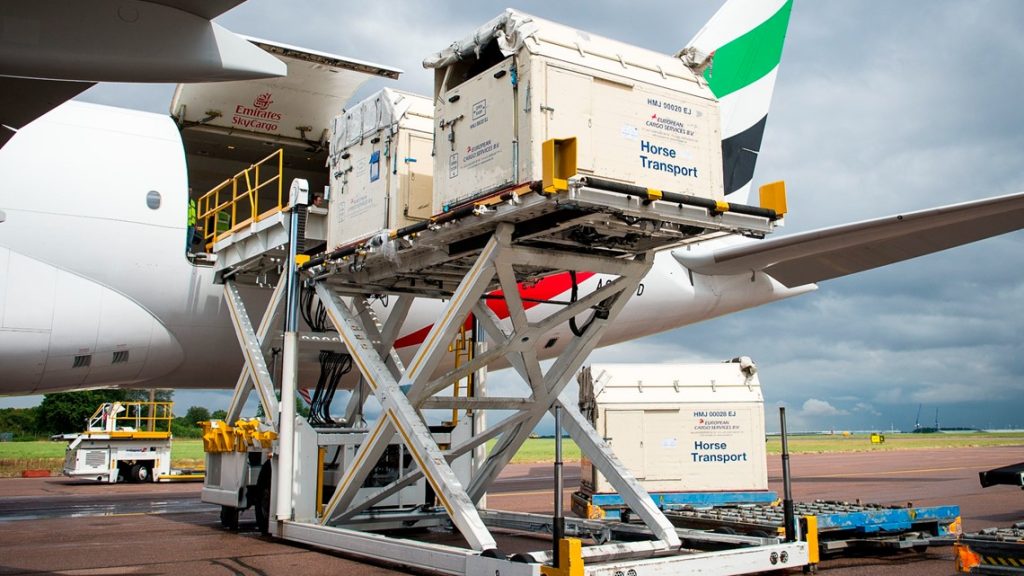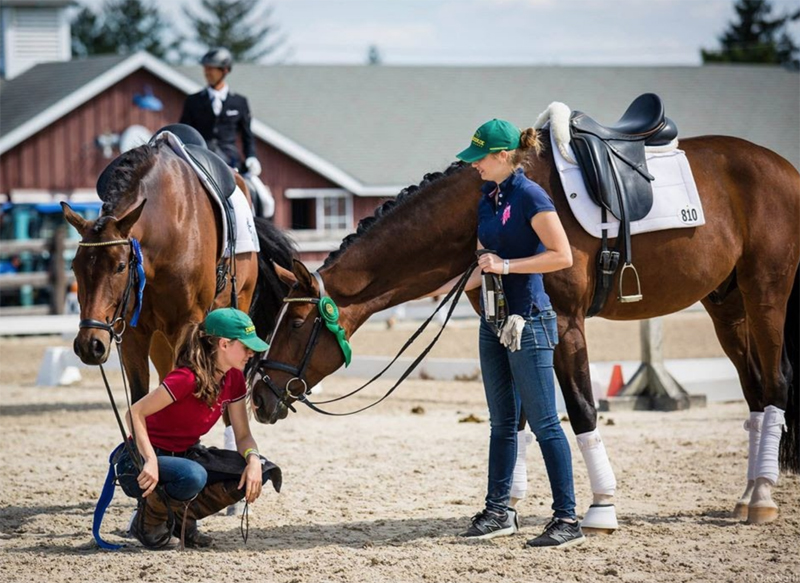Transporting equestrian horses to the Olympics is a complex process. It ensures the animals’ safety and well-being.
Horses, like their human counterparts, require special travel arrangements for Olympic events. The journey involves meticulous planning and coordination. From customized vehicles to specialized care, every detail matters. The horses travel by air, road, or sea, depending on the distance.
They often fly in specially designed aircraft, complete with stalls and expert handlers. This process ensures they arrive healthy and ready to compete. Understanding the logistics behind this transportation highlights the dedication to equestrian sports. It also showcases the care and attention given to these magnificent athletes. We will delve into the fascinating journey of Olympic horses.

Credit: www.youtube.com
Introduction To Equestrian Horse Transport
Equestrian sports are a remarkable blend of skill, grace, and partnership. The bond between horse and rider is unique. Transporting these magnificent animals to international events like the Olympics is a significant task. It requires meticulous planning and specialized care.
Significance Of Equestrian Sports
Equestrian sports hold a special place in the Olympics. They showcase the incredible synergy between horse and rider. These events highlight various disciplines, including dressage, show jumping, and eventing. Each discipline demands precision, agility, and harmony.
Equestrian sports also honor tradition and history. They connect us to our past while pushing the boundaries of modern athleticism. The presence of these sports at the Olympics elevates the entire event.
Challenges In Horse Transport
Transporting horses to the Olympics is a complex task. It involves numerous challenges:
- Health and Safety: Ensuring the horses’ well-being during travel is paramount. They need to be in peak condition to compete.
- Logistics: Coordinating flights, ground transport, and accommodations requires detailed planning.
- Legal Regulations: Navigating international laws and regulations can be daunting. Different countries have specific requirements for animal transport.
Specialized equipment is essential for horse transport. This includes custom-built trailers and crates. Horses must have adequate space and ventilation. They also need access to food and water during the journey.
Expert handlers accompany the horses. These professionals monitor their health and manage any issues that arise. They ensure the horses arrive safely and are ready to compete.
| Challenge | Solution |
|---|---|
| Health and Safety | Regular health checks and specialized care |
| Logistics | Detailed planning and coordination |
| Legal Regulations | Compliance with international laws |
Successful horse transport to the Olympics is a collaborative effort. It involves veterinarians, handlers, and logistics experts. Their combined expertise ensures that these incredible athletes are ready to shine on the world stage.
Pre-transport Preparations
Pre-transport preparations are crucial for equestrian horses heading to the Olympics. These steps ensure horses are healthy and ready for the journey. Let’s explore the key preparations.
Health Check-ups
Every horse must undergo thorough health check-ups. Veterinarians conduct these examinations weeks before departure. They assess overall health, checking for any signs of illness or injury. Any issues must be addressed promptly to ensure the horse is fit for travel.
Vaccination Requirements
Vaccinations are essential for preventing diseases during transport. Each horse needs specific vaccines based on destination requirements. These vaccinations protect against common equine diseases. It is vital to follow vaccination schedules strictly to ensure full immunity before travel.
Specialized Transport Equipment
Transporting equestrian horses to the Olympics requires specialized equipment. This ensures the horses remain safe and comfortable throughout the journey. The process involves using advanced transport methods and high-quality materials. This section explores the specialized transport equipment used for this unique task.
Horse Trailers
Horse trailers are essential for moving horses on the ground. These trailers are designed with the horse’s comfort in mind. They offer ample space and proper ventilation. Trailers also have non-slip floors to prevent accidents. Some trailers even include padded walls to protect the horses. The design ensures a smooth ride, reducing stress on the animals.
Air Transport Containers
Air transport containers are used for international travel. These containers are specially made for equestrian horses. They offer a secure and comfortable environment during flights. Each container can hold multiple horses, separated by partitions. This prevents horses from getting hurt. Containers are equipped with ventilation systems to keep the air fresh. The flooring is also cushioned, providing a stable surface for the horses.
Training For Transport
Training for transport is crucial for Olympic equestrian horses. These majestic animals must travel long distances, often internationally, to compete. This journey can be stressful. Proper training ensures they stay calm and healthy.
Acclimating Horses
Horses need to get used to the transport environment. They start with short trips. This helps them adjust. Gradually, the trips become longer. Horses learn to stay calm in trailers and planes. Familiarity with the sounds and movements is key. They feel safer and less stressed.
Behavioral Conditioning
Behavioral conditioning is another essential part of the training. Horses learn to associate transport with positive experiences. Trainers use treats and gentle handling. This reinforces calm behavior. Horses become less anxious and more cooperative. They trust their handlers more. This trust makes the transport smoother.
Logistics And Planning
Transporting equestrian horses to the Olympics requires meticulous logistics and planning. It’s a complex task ensuring the safety and comfort of these elite animals. Every detail must be considered to avoid any risks during transit.
Route Planning
Route planning is crucial in transporting Olympic horses. Teams choose the shortest and safest routes. They avoid routes with heavy traffic or poor road conditions. This ensures smooth and stress-free travel for the horses.
Teams also consider the weather. Extreme heat or cold can affect the horses’ health. Planners check weather forecasts and select the best travel dates accordingly.
Time Management
Time management is essential for the smooth transport of horses. Horses need regular breaks during long journeys. Teams schedule stops at suitable locations to let horses rest and hydrate.
Arriving on time is vital. Teams must coordinate arrival times with event schedules. This avoids any delays that could affect the horses’ performance.
Proper time management also includes preparation. Teams ensure all documents and health checks are completed well in advance. This prevents any last-minute issues that could delay the journey.

Credit: thehorse.com
On-board Care
Transporting equestrian horses to the Olympics is a significant challenge. One of the most critical aspects is on-board care. Horses require constant attention and care during their journey to ensure they arrive healthy and ready to compete.
Feeding And Hydration
Feeding and hydration are crucial. Horses are provided with high-quality feed and clean water throughout the journey. The diet is carefully planned to maintain their energy levels and health.
- Frequent, small meals
- Fresh water available at all times
- Electrolytes to prevent dehydration
Horses are monitored to ensure they are eating and drinking enough. Any changes in their eating habits are noted and addressed immediately.
Monitoring Horse Health
Monitoring horse health is another vital aspect of on-board care. Veterinarians and groomers are on hand to check the horses regularly.
- Check vital signs like temperature and heart rate
- Inspect for any signs of stress or discomfort
- Ensure the horse is comfortable and relaxed
They use advanced technology to monitor the horses’ conditions. This includes sensors that track movement and vital signs. Any abnormal readings trigger immediate action.
With these measures in place, horses receive the best possible care during their journey. This ensures they arrive at the Olympics in peak condition, ready to compete.
Arrival And Quarantine Procedures
Transporting equestrian horses to the Olympics involves meticulous planning. Upon arrival, horses undergo rigorous quarantine procedures to ensure their health and safety. This process is essential to prevent the spread of diseases and to ensure that the horses are fit to compete.
Customs And Inspections
Upon arrival, the horses are greeted by customs officers. These officers inspect the horses and their documentation. The paperwork includes health certificates and vaccination records.
After the initial check, a team of veterinarians conducts thorough health inspections. They check for any signs of illness or injury. These steps are crucial to maintaining the health of the horses and preventing any potential outbreaks.
Quarantine Facilities
After passing customs and inspections, the horses are moved to quarantine facilities. These facilities are specifically designed to house and monitor the horses.
During the quarantine period, the horses are monitored by veterinarians. The quarantine period typically lasts for about 30 days.
In the quarantine facilities, horses receive top-notch care. They are fed a balanced diet and monitored for any signs of stress or illness. This ensures that they are in peak condition for the competition.
| Step | Description |
|---|---|
| Arrival | Horses arrive at the designated airport. |
| Customs Inspection | Customs officers check documentation and health certificates. |
| Veterinary Check | Veterinarians conduct thorough health inspections. |
| Quarantine | Horses are moved to quarantine facilities for 30 days. |
Post-transport Recovery
Olympic equestrian horses travel in specially designed planes. They rest in spacious stalls during the flight. Upon arrival, they receive immediate care to recover from the journey.
Transporting equestrian horses to the Olympics is a complex process. Horses endure long flights and need special care upon arrival. Ensuring their well-being and readiness is crucial. Post-transport recovery is essential for their health and performance.Rest And Rehabilitation
After a long journey, horses need rest. This period allows them to recover from travel stress. They stay in a calm environment to help them relax. Veterinary checks ensure they are healthy and injury-free. Proper hydration and nutrition are vital. Horses receive balanced diets to replenish lost energy. Gentle exercises aid muscle recovery. This phase is critical for their overall well-being.Performance Readiness
Once rested, horses begin performance training. This prepares them for Olympic events. Trainers focus on light exercises first. These activities help horses regain strength and agility. Gradually, training intensity increases. Horses practice routines specific to their events. This step ensures they are in peak condition. The goal is to achieve optimal performance levels. Trainers and vets monitor progress closely. They adjust plans as needed for each horse. Ensuring horses are ready takes time. Post-transport recovery plays a crucial role. It supports their health and performance at the Olympics. “`Role Of The Care Team
Transporting equestrian horses to the Olympics is a complex task. The role of the care team is crucial in ensuring the horses’ safety and well-being. A dedicated care team includes veterinarians, groomers, and handlers. They work together to manage the horses’ health, comfort, and stress levels during the journey.
Veterinarians
Veterinarians play a vital role in the care team. They ensure the horses are healthy and fit for travel. Vets conduct thorough health checks before the trip. They monitor the horses during transportation. They also provide any necessary medical treatments. This helps to prevent any health issues during the journey.
Groomers And Handlers
Groomers and handlers are essential for maintaining the horses’ well-being. Groomers keep the horses clean and comfortable. They manage the horses’ coats, hooves, and general appearance. Clean horses are less likely to develop skin issues during travel.
Handlers are responsible for the horses’ safety. They manage the loading and unloading process. They also ensure the horses are calm and stress-free. Handlers provide food and water during the trip. They make sure the horses are comfortable in their transport stalls. The care team works tirelessly to ensure the horses arrive at the Olympics in top condition.

Credit: thehorse.com
Challenges And Solutions
Transporting equestrian horses to the Olympics is a logistical challenge. These majestic animals require special care and attention. The journey is complex, involving detailed planning and execution. Various factors must be considered to ensure the horses’ well-being. Here, we discuss the main challenges and their solutions.
Dealing With Stress
Horses can easily become stressed during transport. The unfamiliar environment and long travel can affect their health. To minimize stress, horses are acclimated to travel conditions beforehand. They are trained to enter and exit transport vehicles calmly. Soft bedding and sufficient ventilation provide comfort. Regular stops allow the horses to rest and recover.
Professional handlers accompany the horses. They monitor their condition and provide reassurance. Ensuring a familiar routine helps reduce anxiety. Proper hydration and feeding are maintained throughout the journey.
Ensuring Safety
Safety is paramount during the transport of equestrian horses. Secure and well-maintained transport vehicles are crucial. These vehicles have special features for horse safety. Non-slip flooring and padded walls prevent injuries. Horses are securely tied to avoid sudden movements.
Experienced drivers follow safe driving practices. They avoid sudden stops and sharp turns. Continuous monitoring ensures the horses’ safety and comfort. Emergency medical kits and vets are available in case of unforeseen issues.
Special permits and documentation are also required. These ensure that all regulations are followed. Regular checks and inspections ensure compliance with safety standards.
Frequently Asked Questions
How Are Horses Transported Internationally For The Olympics?
Horses are transported internationally by air in specialized cargo planes. These planes are equipped with stalls to ensure the horses’ safety and comfort. The horses are accompanied by grooms and veterinarians to monitor their well-being throughout the journey.
What Special Care Do Horses Receive During Transport?
During transport, horses receive constant monitoring from grooms and veterinarians. They are provided with food, water, and rest to keep them comfortable. The stalls are designed to minimize stress and prevent injuries.
How Long Does It Take To Transport A Horse?
The duration of horse transport depends on the distance and logistics. International flights can take several hours to a day. After the flight, horses may need additional time for acclimatization and rest.
What Documents Are Required For Horse Transportation?
Transporting horses internationally requires various documents, including health certificates, import permits, and vaccination records. These documents ensure the horses meet the health and safety regulations of the destination country.
Conclusion
Transporting equestrian horses to the Olympics is a complex process. It requires detailed planning and special care. Horses travel by air using custom-designed planes. These planes ensure safety and comfort. Experienced handlers accompany the horses. They monitor their needs throughout the journey.
Veterinary checks are frequent. This ensures the horses remain healthy. Upon arrival, quarantine procedures are followed. This prevents the spread of diseases. The entire process prioritizes the horses’ well-being. Ensuring they arrive in peak condition is crucial. This careful transport allows them to perform their best at the Olympics.



